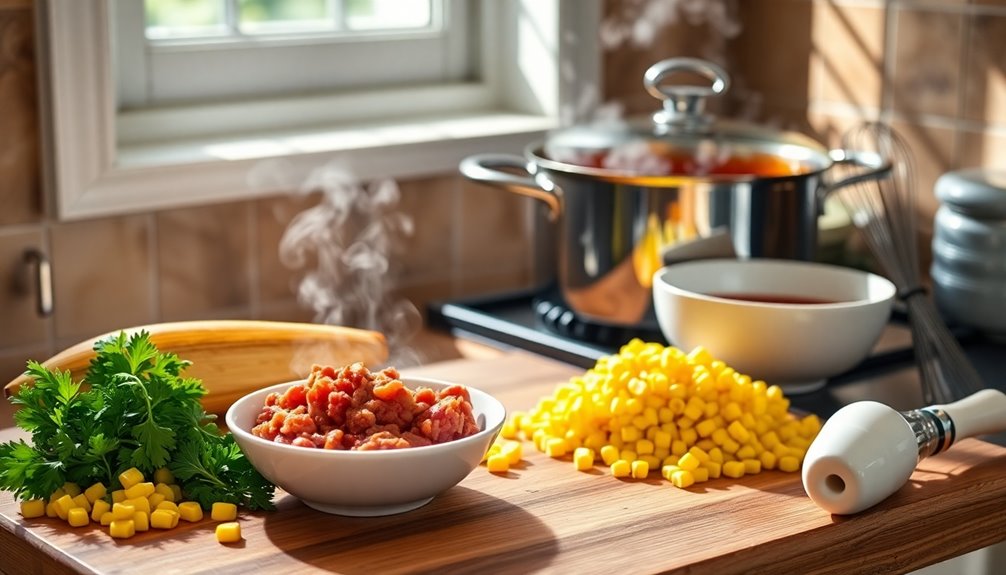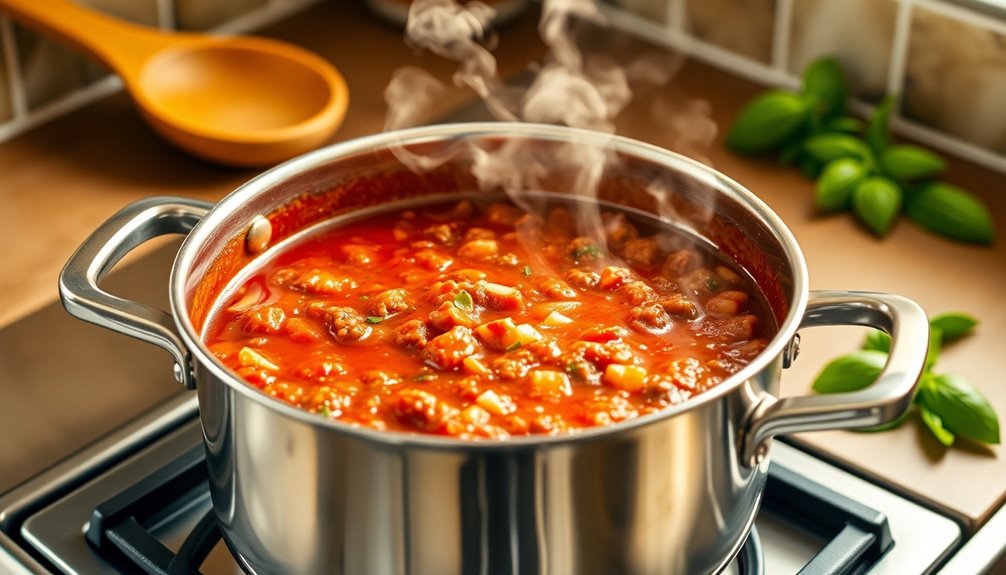An omelet with corn and Bolognese sauce is a delightful blend of creamy, fluffy eggs, sweet corn, and rich, meaty sauce. Start by whisking eggs and cooking them in a skillet until light and fluffy. Then, add sautéed corn and Bolognese sauce before folding the omelet. The dish is not only quick to prepare but also packs a punch of flavor. If you're curious about variations and presentation tips, there's more to explore.
History

The omelet's history is rich and diverse, tracing back to ancient civilizations where simple egg dishes first emerged.
The omelet's journey spans ancient civilizations, evolving from humble egg dishes into a beloved culinary staple.
Over centuries, this dish evolved, with the French version gaining popularity in the 19th century. The term "omelet" comes from the French word "amelette," referring to its flat shape.
Traditionally made with just eggs, omelets now incorporate a variety of fillings, reflecting local tastes. You might enjoy the impressive fusion of Italian and French culinary traditions by pairing omelets with Bolognese sauce.
This combination highlights the dish's versatility, allowing for creative adaptations. Additionally, using corn as a filling adds a unique sweetness and texture, beautifully complementing the savory richness of Bolognese sauce and enhancing your dining experience. The incorporation of natural elements in culinary presentations can elevate the overall appeal, making meals more inviting and enjoyable.
Recipe

To make this omelet, you'll need to whisk together eggs and cook them to a light fluff before adding your prepared filling. The Bolognese sauce, paired with sautéed corn, offers a wonderful contrast to the creamy eggs. For an added layer of flavor, you can incorporate cheese—such as crumbled goat cheese or shredded mozzarella—into the filling, which melts beautifully and enhances the overall dish. Additionally, this omelet can be a quick breakfast option that provides a protein-rich start to the day.
Ingredients:
- 4 large eggs
- 1 cup Bolognese sauce
- 1 cup corn (fresh or frozen)
- 1/2 cup crumbled goat cheese or shredded mozzarella
- Salt and pepper to taste
- 1 tablespoon olive oil or butter
- Fresh herbs (optional, for garnish)
Cooking Instructions:
In a bowl, whisk together the eggs, adding a pinch of salt and pepper.
Heat olive oil or butter in a non-stick skillet over low to medium heat.
Pour in the egg mixture and cook gently, lifting the edges to allow uncooked eggs to flow underneath.
Once the eggs are mostly set, spoon the Bolognese sauce and sautéed corn onto one half of the omelet, then sprinkle with cheese.
Carefully fold the other half over the filling and let it cook for another minute until the cheese has melted and the omelet is cooked through.
Extra Tips:
For the best results, make sure to cook the omelet over low to medium heat to avoid browning the eggs too much.
You can also customize your omelet by adding sautéed vegetables or herbs to the filling for extra flavor.
If you're using frozen corn, make sure to thaw and drain it well before adding to the omelet.
This dish is best served hot, so enjoy it fresh off the skillet!
Cooking Steps

To get started, you'll want to prepare all your ingredients for cooking.
Make sure to cook the meat sauce thoroughly for the best flavor.
Then, whisk the eggs with seasoning to create a smooth mixture before pouring it into the skillet. Additionally, using butter's composition in your cooking can enhance the richness of the omelet.
Step 1. Prepare Ingredients for Cooking

Start by gathering all your ingredients so everything's within reach. You'll need fresh or frozen corn, eggs, butter, crumbled goat cheese, and Bolognese sauce. Make sure each ingredient is measured and ready for use.
Next, finely chop any additional vegetables or herbs, like chives, to enhance your omelet's flavor. Don't forget to separate the egg whites from the yolks; this is crucial for achieving a fluffier texture in your omelet.
Preheat your skillet over medium heat and melt a portion of the butter, ensuring it coats the pan evenly.
Lastly, sauté the corn in the butter until it's tender, then add the garlic and mix in the Bolognese sauce before combining it with your whisked eggs in the pan. Additionally, using high-quality equipment can significantly improve your cooking results by ensuring even heat distribution.
Step 2. Cook Meat Sauce Thoroughly

Begin by browning the meat in a hot pan, which enhances the flavor through the Maillard reaction.
Make sure you stir the meat frequently to achieve even browning and prevent clumping.
You'll want to cook the meat sauce thoroughly until it reaches an internal temperature of at least 160°F (71°C) to eliminate harmful bacteria.
Once the meat is partially cooked, add a bit of chopped onions and garlic to infuse the sauce with more flavor.
After that, stir in the chopped tomatoes, and let the sauce simmer for at least 30 minutes.
This allows the flavors to meld beautifully while the sauce thickens, creating a rich and savory base for your omelet. Additionally, incorporating cultured butter can elevate the richness of your sauce, enhancing the overall taste experience.
Step 3. Whisk Eggs With Seasoning

Once you've prepared your meat sauce, it's time to whisk the eggs with seasoning for your omelet.
Start by cracking about three large eggs into a mixing bowl. Add a pinch of salt and pepper to enhance their flavor; you can also throw in garlic powder or herbs if you like.
Grab a whisk or a fork and beat the eggs vigorously until the yolks and whites are fully combined, creating a slightly frothy mixture.
If you want, mix in grated cheese or cooked vegetables for extra taste and texture.
Make sure the mixture is well blended, achieving a uniform consistency that'll help your omelet cook evenly when you pour it into the skillet. Additionally, incorporating lean meats can enhance the protein content of your meal.
Enjoy the process!
Step 4. Pour Eggs Into Skillet

Preheat your skillet over medium heat and lightly grease it with butter or oil to prevent sticking.
Once your eggs are whisked until they're well combined and slightly frothy, it's time to pour eggs into the skillet.
Pour the egg mixture into the center, letting it spread evenly across the surface. As the edges start to set, gently pull them towards the center with a spatula, tilting the skillet so uncooked egg can flow to the edges.
Allow the omelet to cook undisturbed until the bottom is set but the top remains slightly runny. This technique ensures a fluffy texture, setting the stage perfectly for the addition of bolognese sauce and your favorite fillings. Additionally, the right cooking method can help improve toilet functionality by ensuring a well-maintained and efficient kitchen environment that reflects overall home hygiene.
Step 5. Add Cheese Before Folding

As the omelet cooks and the edges begin to set, it's the perfect moment to sprinkle a generous amount of cheese over the surface.
Choose cheeses that melt well, like cheddar, mozzarella, or goat cheese, ensuring a smooth, gooey filling. Adding cheese at this stage allows it to partially melt, creating a cohesive texture that adheres better to the omelet.
For a balanced taste, consider mixing sharp cheese for a flavor kick with a milder cheese for creaminess.
Once you've added the cheese, fold the omelet over it. This seals in the filling and helps the cheese melt evenly, resulting in a deliciously satisfying bite.
Incorporating essential oils into your cooking can enhance flavors and provide health benefits, so consider experimenting with them in your recipes.
Enjoy the creamy, cheesy goodness of your perfectly folded omelet!
Final Thoughts

While combining corn with Bolognese sauce in an omelet may sound unconventional, it can lead to a delightful culinary experience if approached thoughtfully.
To create a balanced dish, consider using a lighter Bolognese sauce that won't overpower the corn's sweetness. Adding cheese enhances the flavors and gives a creamy texture that ties everything together.
Don't hesitate to experiment with alternative fillings like sautéed vegetables or fresh herbs; they can complement both the corn and Bolognese beautifully.
For a visually appealing presentation, serve your omelet alongside a fresh salad or sprinkle it with herbs.
This unique omelet can easily become a star dish, reminiscent of a comforting casserole dish, bringing warmth and satisfaction to your meal. Exploring global flavors can inspire your culinary creativity and make every meal memorable.
Enjoy the fusion!
Frequently Asked Questions
Can You Put Corn in an Omelette?
Yes, you can definitely put corn in an omelette! It adds a sweet and crunchy texture that complements the creamy eggs beautifully.
Whether you use fresh or frozen corn, just sauté it briefly in butter to enhance its flavor before mixing it into your eggs.
Corn pairs well with various ingredients, like cheese and herbs, making it a versatile choice for your omelette.
What Goes Best With Bolognese Sauce?
Well, if you think eating Bolognese sauce on its own is gourmet, think again!
You'll want to pair it with wide pasta like tagliatelle, which embraces that rich sauce like a long-lost friend. A sprinkle of Parmesan? Absolutely! It's like the cherry on top.
Toss in some fresh herbs for flair, and don't forget crusty bread to sop up every last drop. A light salad can balance the richness too.
Bon appétit!
What Is the Difference Between Bolognese Sauce and Spaghetti Sauce?
Bolognese sauce and spaghetti sauce differ mainly in their ingredients and preparation.
Bolognese is a rich, meat-based sauce that includes ground meat, tomatoes, and vegetables, simmered slowly for depth of flavor.
In contrast, spaghetti sauce is primarily tomato-based, often lighter and quicker to make.
While Bolognese pairs best with thicker pasta like tagliatelle, spaghetti sauce is perfect for, you guessed it, spaghetti noodles.
Each brings its own unique taste to the table!
Can You Put Egg in Bolognese Sauce?
You can definitely put egg in Bolognese sauce! Adding a beaten egg can enhance the richness and creaminess of the dish.
If you mix it in carefully, it can create a thicker, velvety texture. Just remember to temper the egg by slowly incorporating it into the warm sauce to avoid curdling.
This technique can elevate your Bolognese, making it perfect for pasta or even as a filling in baked dishes. Enjoy experimenting!
Conclusion
Who knew that a simple omelet could become a culinary masterpiece with just a twist of corn and a dash of bolognese sauce? You've taken breakfast to a whole new level, proving that even the most humble ingredients can shine. It's almost ironic, isn't it? You started with an ordinary meal and ended up creating something extraordinary. So, the next time you whip up an omelet, just remember: it might turn into a five-star dish right in your kitchen!









